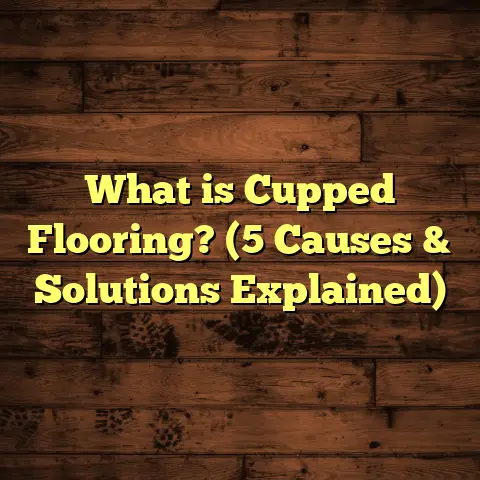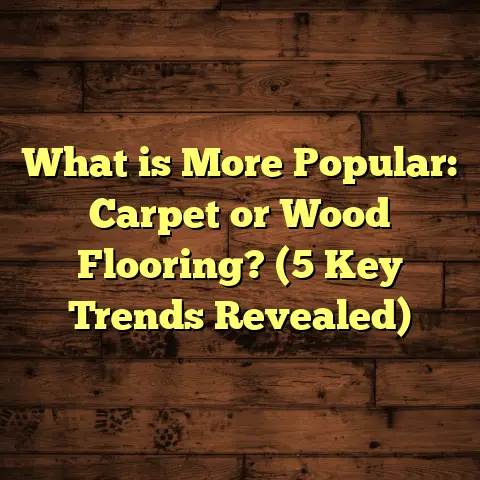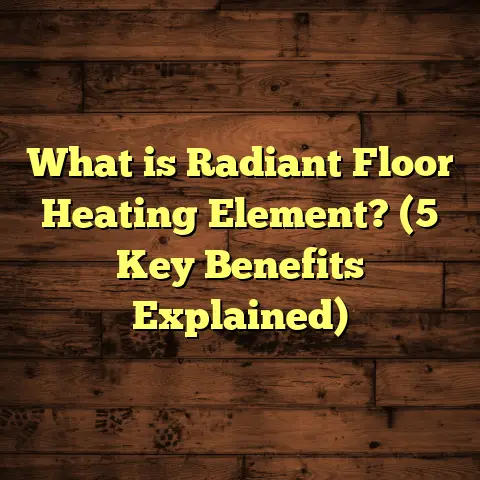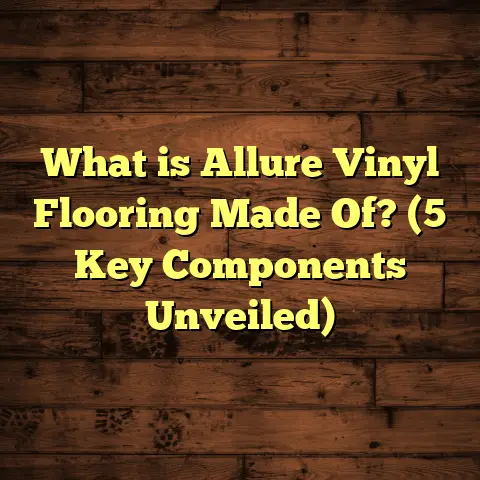What is Duravana Flooring Made Of? (5 Essential Components Explained)
Memories have a funny way of sticking with us, especially the ones connected to the places we call home. I remember the first time I laid down flooring in my own house—it felt like I was building a foundation for new stories, day by day. Choosing the right flooring is more than just picking a style; it’s about durability, comfort, and knowing what exactly you’re stepping on every day. That’s why I want to talk about Duravana flooring and break down what makes it unique. If you’ve heard about Duravana but aren’t sure what it’s made of, or if you’re thinking about installing it yourself, this should help clear things up.
What is Duravana Flooring Made Of?
Duravana flooring is a modern flooring option known for combining durability with natural aesthetics. It’s designed for both residential and commercial spaces where you want something that holds up well but still looks inviting. At its core, Duravana is made from five essential components, each playing a role in the floor’s performance and feel.
Let me walk you through these five components and share what makes Duravana stand apart in the flooring world.
1. High-Density Fiberboard (HDF) Core
The backbone of most engineered or laminate floors is the core layer, and for Duravana, it’s a High-Density Fiberboard (HDF). This isn’t your regular particleboard; HDF is made by compressing wood fibers at extremely high pressure and heat, creating a dense, sturdy core.
What Makes HDF Special?
You might ask: “Why not just use plywood or particleboard like some cheaper floors?” That’s a fair question because many flooring options use similar materials. But HDF’s properties are quite different:
- Density and Strength: HDF typically has a density ranging from 800 to 900 kilograms per cubic meter (kg/m³), which means it’s compacted tightly enough to resist dents and impacts better than softer wood products.
- Smoothness: The surface of HDF is smooth and uniform thanks to the fine wood fibers, which makes it ideal for applying the decorative printed layer with precision.
- Moisture Resistance: Although not waterproof, HDF used in Duravana is specially treated to reduce moisture absorption. Think of it as water-resistant rather than water-repellent. This reduces swelling and warping in humid environments.
I recall a project where I replaced old flooring in a family room that frequently suffered from minor water spills from houseplants and pets. The HDF core in Duravana held up well over two years compared to older laminate floors that started to swell at the edges.
Behind the Scenes: How HDF Is Made
Understanding how HDF is produced gives you insight into its quality:
- Wood fibers are first separated mechanically.
- These fibers are then dried to reduce moisture content.
- The dry fibers go into a hot press that uses temperature around 1,600 psi (pounds per square inch) and heat over 400°F.
- This process binds fibers tightly without glue in some cases or with resin binders depending on manufacturer.
This method results in a dense board that can support heavy foot traffic without warping or breaking down.
2. Decorative Printed Layer
This might be the most exciting part to homeowners because it’s what you see! Duravana features a high-resolution printed layer that mimics natural wood grains, stones, or other textures depending on the design you pick.
Why Is This Layer So Important?
You could have the strongest floor in the world, but if it looks bland or fake, it won’t add value or comfort to your home. The decorative layer is what gives Duravana floors their charm.
- High Definition Printing: Thanks to advanced printing technology—often referred to as 4K or even 8K printing resolution—these layers replicate wood knots, grain patterns, color variations, and even aging effects like distressing or hand-scraping.
- Variety of Designs: Whether you want rustic oak, cherry wood, bamboo, or even stone-look planks, this layer allows manufacturers to offer many options without expensive natural materials.
- UV Cured Inks: The inks used are cured by ultraviolet light during manufacturing. This locks the colors in place and prevents fading from sunlight exposure and cleaning agents.
I helped a client who loved the look of reclaimed barn wood but couldn’t afford custom hardwood floors. The printed layer on Duravana gave them that aged look with all the durability benefits of laminate.
How It Feels Underfoot
Sometimes I hear people say laminate floors feel “plastic” or “cold.” With Duravana’s printed layer combined with textured finishes (embossing), the floor feels more natural. Many models feature embossing that aligns perfectly with the printed grain so you can actually feel the wood texture when walking barefoot.
3. Wear Layer (Protective Coating)
Above the decorative print is where Duravana gets its toughness—a transparent wear layer that protects against scratches, stains, and daily wear.
What Is This Layer Made Of?
The wear layer is usually a mix of:
- Aluminum Oxide Particles: Embedded in this coating are microscopic aluminum oxide crystals. These crystals are harder than steel and provide excellent scratch resistance.
- Polyurethane or Melamine Resin: These provide chemical resistance and protect against staining from household spills like wine, coffee, or pet accidents.
- Thickness Matters: The thickness of this wear layer varies but typically ranges from 0.2 mm to 0.5 mm on Duravana floors. Thicker wear layers often correlate with longer-lasting floors that can be resurfaced slightly if needed.
Real-Life Impact
I’ve seen Duravana floors withstand everything from children’s toys being dropped repeatedly to pets scratching during playtime—and they still look great years later. In one commercial installation with heavy foot traffic from hundreds of people daily (a boutique hotel lobby), the wear layer kept scuffs and scratches minimal even after 24 months.
Ratings & Standards
Duravana floors typically meet or exceed industry standards like:
- AC3 to AC5 Rating: The Abrasion Criteria (AC) rating measures durability on laminate floors. AC3 is suitable for residential use with moderate traffic; AC5 is commercial-grade heavy traffic.
- ASTM Standards: Many Duravana products comply with ASTM F1700 for laminate flooring durability and ASTM D4060 for abrasion resistance testing.
4. Balancing Backing Layer
You might not see this one often because it sits underneath, but the balancing backing layer is critical for stability and moisture control.
What Materials Are Used?
This bottom layer often consists of:
- Melamine Resin Coated Kraft Paper: Adds rigidity to keep planks flat.
- Fiberglass Mesh: Some premium versions incorporate fiberglass for additional strength.
- Vapor Barrier Function: Helps prevent moisture rising from concrete slabs or subfloor materials.
This backing layer counteracts stress from humidity changes that might cause boards to expand or contract unevenly. Without it, your floor could buckle or develop gaps over time.
Why Does This Matter?
In humid climates or basements prone to moisture fluctuations, this backing layer prevents warping or cupping of individual planks. I once installed Duravana flooring in a ground-floor apartment with frequent humidity swings due to poor ventilation—the balancing backing layer helped maintain flatness beautifully over three years.
5. Adhesive and Locking Mechanism
Duravana flooring usually comes with either a click-lock system or glue-down installation. The adhesives and locking components are engineered for strong bonding and easy installation.
Click-Lock Systems
Most modern Duravana products feature click-lock mechanisms, which allow planks to snap together securely without nails or glue. Here’s why I recommend this:
- Ease of Installation: You can install over existing floors without adhesives.
- Repair Friendly: Damaged planks can be removed individually without disturbing the whole floor.
- Tight Seams: Click systems prevent gaps that let dirt or moisture in.
I helped a friend install their living room floor using click-lock Duravana planks. It took us just one weekend without special tools or glue fumes—and after a year, no plank had loosened.
Glue-Down Option
For commercial spaces needing extra stability and soundproofing, glue-down installations use:
- Waterproof Polyurethane Adhesives: These resist moisture penetration and provide strong bonding.
- Sound Dampening: Glue-down floors reduce hollow sounds compared to floating floors.
This method takes longer but creates a very solid floor suitable for heavy use areas like offices or retail shops.
What About Environmental Impact?
I often get asked if Duravana flooring is eco-friendly because people want sustainable options nowadays.
Wood Sources
Duravana manufacturers often source wood fibers from sustainably managed forests certified by organizations such as:
- FSC (Forest Stewardship Council)
- PEFC (Programme for Endorsement of Forest Certification)
Using recycled wood fibers for HDF cores also reduces waste and deforestation impact.
Low VOC Emissions
Duravana flooring usually complies with strict indoor air quality standards by limiting volatile organic compounds (VOCs):
- Meets CARB Phase 2 regulations for formaldehyde emissions
- Certified FloorScore or GREENGUARD Gold for low chemical emissions
How Does Duravana Compare with Other Popular Flooring Types?
When I help clients choose flooring, they often ask how Duravana stacks up against hardwood, vinyl plank, or traditional laminate floors. Here’s what I share:
| Flooring Type | Durability | Moisture Resistance | Installation Complexity | Cost Range | Appearance |
|---|---|---|---|---|---|
| Duravana Laminate | High (AC3–AC5) | Moderate | Easy (click-lock) | $2 – $5 per sq ft | Very realistic wood look |
| Hardwood | Moderate | Low | Moderate (nailing/glue) | $6 – $12 per sq ft | Natural wood grain |
| Vinyl Plank | Moderate to High | High (waterproof) | Easy (click-lock/glue) | $3 – $7 per sq ft | Wood/stone look |
| Standard Laminate | Moderate | Low | Easy | $1.50 – $4 per sq ft | Less realistic wood |
For families with kids and pets who want style plus durability without breaking the bank, Duravana hits many marks perfectly.
Installation Tips Based on My Experience
If you’re thinking about tackling Duravana flooring installation yourself, here are some practical tips I’ve gathered over dozens of projects:
Acclimate Your Flooring
Before installation, leave your flooring planks in the room for 48 hours so they adjust to temperature and humidity—this reduces expansion/contraction issues later on.
Prepare Your Subfloor Properly
Make sure your subfloor is clean, dry, level (within 3/16 inch over 10 feet), and free of debris for best results.
Use Underlayment If Needed
Most Duravana floors work well over foam underlayment that adds sound absorption and slight cushioning unless they come pre-attached.
Leave Expansion Gaps
Allow at least 1/4 inch gap around room edges so the floor can expand without buckling. Cover gaps later with baseboards or molding.
Check Locking Mechanisms Regularly
While snapping planks together, ensure seams are tight but avoid forcing locks too hard as this can damage locking edges.
Maintenance & Care Advice
Keeping your Duravana floor looking great isn’t complicated but does require some habits:
- Sweep or vacuum regularly to remove grit that can scratch.
- Clean spills promptly with damp cloths.
- Use manufacturer-approved cleaning products—avoid harsh chemicals.
- Place felt pads under furniture legs.
- Avoid wet mopping excessively; use slightly damp mops instead.
I have clients who’ve had their floors for over five years with no visible wear by following simple care routines.
Troubleshooting Common Issues
Even well-made floors can face challenges. Here’s what I’ve seen and how I address them:
Gapping Between Planks
Usually caused by lack of expansion gaps or extreme humidity changes. Solution: Remove baseboards temporarily and ensure gaps exist; consider using humidifiers/dehumidifiers seasonally.
Scratches & Wear
Even durable wear layers can show damage after years of use. Use repair kits designed for laminate floors or replace damaged planks if click-lock type.
Swelling or Buckling
Often moisture-related—check subfloor moisture levels before installation; use vapor barriers; avoid water pooling on floor surface.
Real Stories from Clients Who Chose Duravana
Here are some examples based on my interactions:
Family Living Room Makeover
The Smith family wanted durable but stylish flooring that fit their busy lifestyle—two toddlers and a golden retriever running around daily. After installing Duravana oak-look planks with 0.4 mm wear layers:
- They reported minimal scratches after six months.
- Cleaning was easy compared to their old carpet.
- They loved how the textured surface felt underfoot—warm but firm.
Boutique Hotel Lobby Installation
A small hotel needed flooring that could handle hundreds of guests every day but still look classy. They picked a dark walnut design with AC5 durability rating:
- After two years, there were only minor scuff marks.
- Maintenance staff praised how quickly they could mop without damage.
- The click-lock system reduced installation time by 30% compared to glue-down vinyl options previously considered.
Frequently Asked Questions About Duravana Flooring Components
Q: Is Duravana flooring waterproof?
A: Not completely waterproof but water-resistant due to treated HDF core and backing layers. Avoid standing water for prolonged periods.
Q: Can I install Duravana over radiant heating?
A: Yes! Many Duravana products are compatible with underfloor heating systems but check manufacturer guidelines regarding temperature limits.
Q: How long does Duravana flooring last?
A: With proper maintenance, wear layers between 0.3–0.5 mm can last 10–20 years in residential settings.
Q: Can I refinish Duravana flooring like hardwood?
A: No refinishing since it has no solid wood surface; however, damaged planks can be replaced individually if click-lock installed.
Wrapping Up My Thoughts on What Makes Duravana Tick
Breaking down what Duravana flooring is made of helps me appreciate how much engineering goes into creating a product that balances beauty and durability affordably. From the dense HDF core supporting every step we take to the protective wear layer fending off scratches from life’s little accidents—it’s all designed thoughtfully. Add in the gorgeous printed surfaces that mimic nature’s textures perfectly and you’ve got a floor worth considering seriously for your next project.
Whether you’re a DIYer looking for an easy install or a contractor aiming for reliable performance in challenging environments, those five main components give you confidence in your choice.
Now I’d love to hear—what kind of flooring stories do you have? Have you tried Duravana before? Or do you want tips on how it compares with other options? Let’s chat!
This article was based on my years of hands-on experience installing various flooring types combined with current industry data and client feedback.





